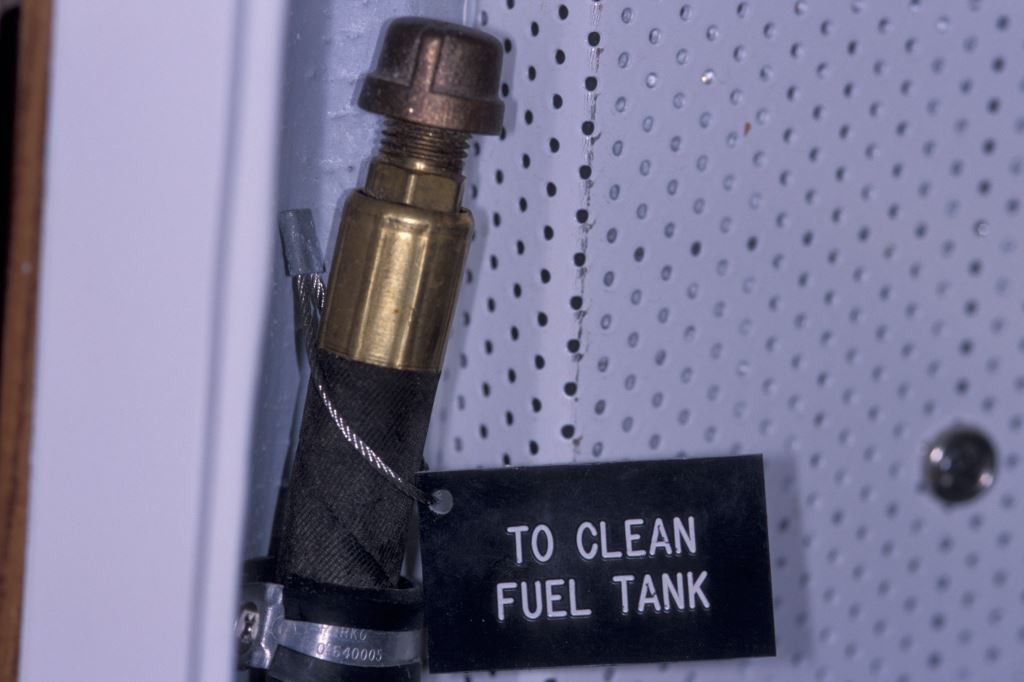Text and photos copyright © 2017 Steve D’Antonio Marine Consulting, Inc.
From the Masthead
Boat Buying Myth Busting
Not long ago a client called me to share an exchange he’d had with a broker selling a vessel he was interested in purchasing, “Steve, I spoke with Bill [not his real name] the broker, he said you were unavailable for an inspection, is that true? When we last spoke you said you had availability”. I was puzzled at first, but ultimately not surprised. While neither I nor my assistant had been contacted by Bill to inquire about availability, this is by no means the first time this has happened. Simply put, I’m the last person many brokers want involved in a sale, and some will do almost anything to scupper my participation. Bill apparently opted to mislead his client into believing I wasn’t available, in a clear effort to keep me out of the equation. In responding I made it clear I was available and would be happy to assist. The client confronted the broker with this information. The broker, in his defense said, ‘If you don’t want the sale to go through, hire Steve. He’s a deal killer’.
In the ten years I’ve been offering Pre-Purchase Inspections and other consulting services, December 1st was our anniversary, I’ve been confronted with this scenario on a number of occasions, particularly the part about me being a deal “cooler” (“The Cooler” with William H. Macy, is a great movie and highly recommended by the way). In an effort to bust that pervasive myth, I’ve spent some time compiling statistics for a new web page I’m working on, several of which are directly related to the many Pre-Purchase inspections I’ve carried out in the last decade. One in particular, however, stands out, 88%: The percentage of SDMC Pre-Purchase Inspection Clients who proceeded with the purchase of their chosen inspected vessel. Thus dispelling the “deal cooler” myth.
By no means am I suggesting all brokers are as unscrupulous as this one. A few understand the work I do and appreciate the professionalism and impartiality for which I strive. The irony is, after they’ve seen me work many brokers acknowledge that I’m not the Boogey Man after all, agreeing, even if they don’t like it, that my observations are reasonable and fair. Some even ask for a business card.
To be clear, unless you are told by one of my staff or me that I am unavailable, don’t believe it; trust but verify. Finally, if a broker says, “You can hire Steve after you get the boat”, please don’t follow that advice either. After the sale you’ve forfeited all of your bargaining power, not to mention the ability to walk away if the vessel wasn’t accurately represented, or if she didn’t live up to your, and my, expectations.
Boat Shows and the Marine Industry
This fall I attended several major boat shows and industry trade events, including the Fort Lauderdale Boat Show, the International Boat Builders’ Exhibition (IBEX) in Tampa, Florida, and the Marine Equipment Trade Show (METS) in Amsterdam, the Netherlands. The volume of new and interesting gear, and boats, along with an enthusiastic attitude among both exhibitors and attendees, is the best I can recall in recent memory. I’ll write a column detailing some of the most interesting products I encountered at these shows, look for it in the New Year.
With few exceptions, the marine industry is strong and surging ahead (and the recently-passed Tax Reform will almost certainly give the industry a further boost; among other things it includes preservation of the second-home interest deduction for boats, albeit with a lower mortgage interest cap of $750,000, down from $1m, and importantly for marine business the the R&D tax credit is preserved under the package), further highlighting the need for skilled boat building, repair and refit staff, along with the education and training they’ll need to do their jobs. If you are ambitious, have good attention to detail, are curious, and enjoy both learning and being challenged, the marine industry is in desperate need of folks like you.
I wish all readers a Merry Christmas, Happy Hanukkah, and all the best for the New Year.
This month’s eMagazine feature article covers the subject of diesel fuel tank cleaning. I hope you find it both interesting and useful.
Cleaning Diesel Tanks
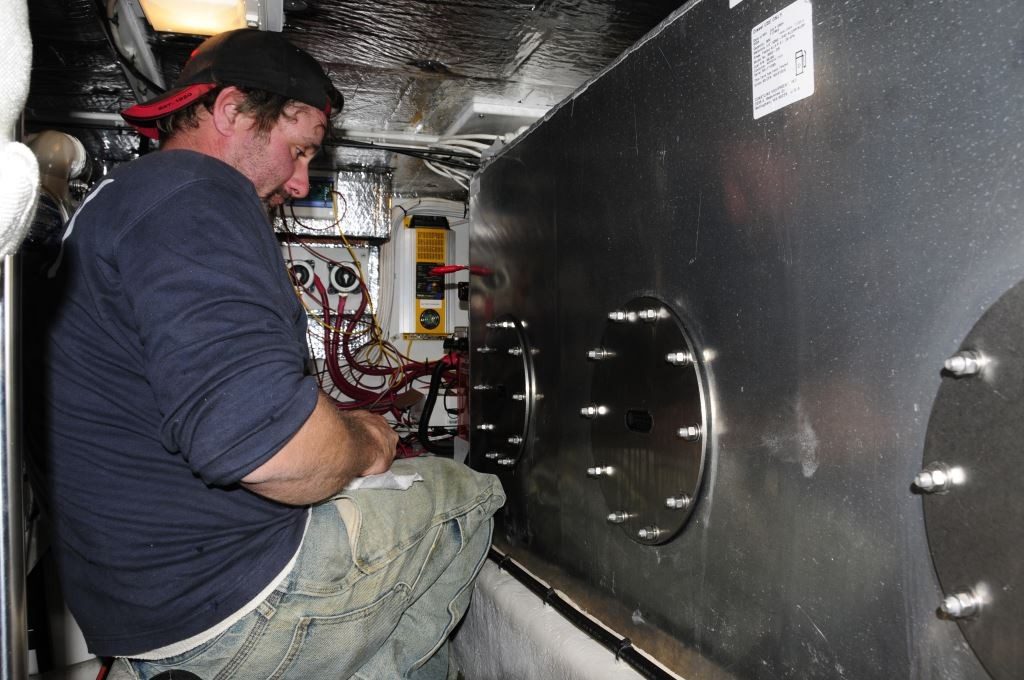
A technician inspects recently installed inspection ports. While virtually all tanks should be built with inspection ports many aren’t. Fortunately, adding them is no longer as difficult as it once was.
It’s a familiar sight, a vessel limps into an anchorage, marina or boat yard, engine barely ticking over, after a rough passage. A lively seaway has stirred up dormant gremlins lying in wait at the bottom of the fuel tank. Years of accumulated sludge, muck, water and biological growth mix with the fuel in the tank, quickly overwhelming the primary fuel filter, slowing the engine to an idle regardless of throttle position. This scenario may be familiar to some; however, it can be more than just a nuisance. In heavy weather conditions, or when transiting a lee shore or narrow inlet, a handicapped or inoperative engine can place a vessel and her crew in extremis.
The above outline of events is a clear illustration of the importance of keeping one’s fuel tanks clean. If fuel filters are clogging routinely, if they need to be replaced before 1,000 gallons of fuel have been burned, then it can mean just one thing; the tanks are contaminated.
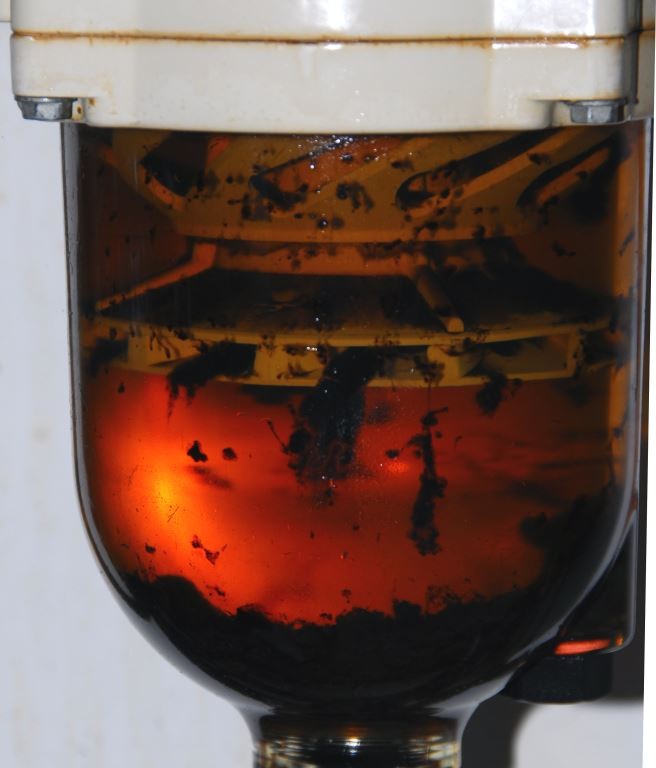
Fuel filters are a window to the soul of the fuel tank. If they are clogging, and require replacement before 1,000 gallons of fuel have been used, it’s likely the tanks are in need of cleaning.
The quality of diesel fuel is sometimes questionable, and while issues are more likely as one ventures further off the beaten path, you simply never can tell when and where you’ll pump contaminated fuel. I took on some of the cleanest diesel I’ve ever seen from a remote fuel depot in Greenland, it came with a test certificate and liter sample in a clear bottle; while the most contaminated diesel fuel I ever encountered was at a fuel dock in The Carolinas. Still, tank contamination issues can be the result of a single load of bad fuel, or years’ worth of accumulated water, biological growth or dirt. Regardless, once a tank is contaminated, there is but one course of action to remedy the situation.
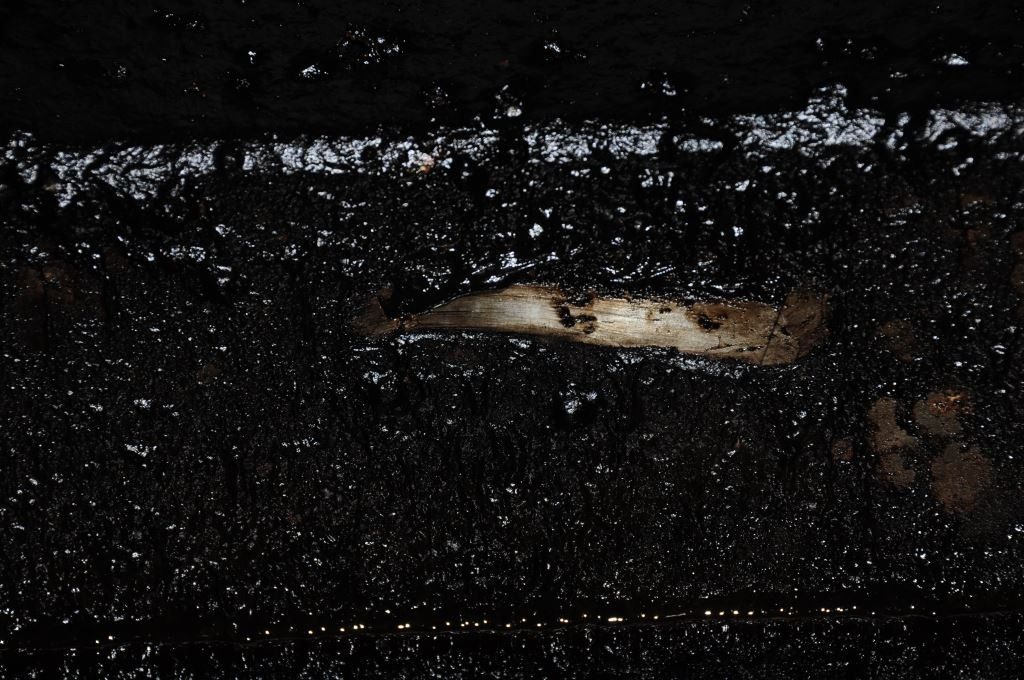
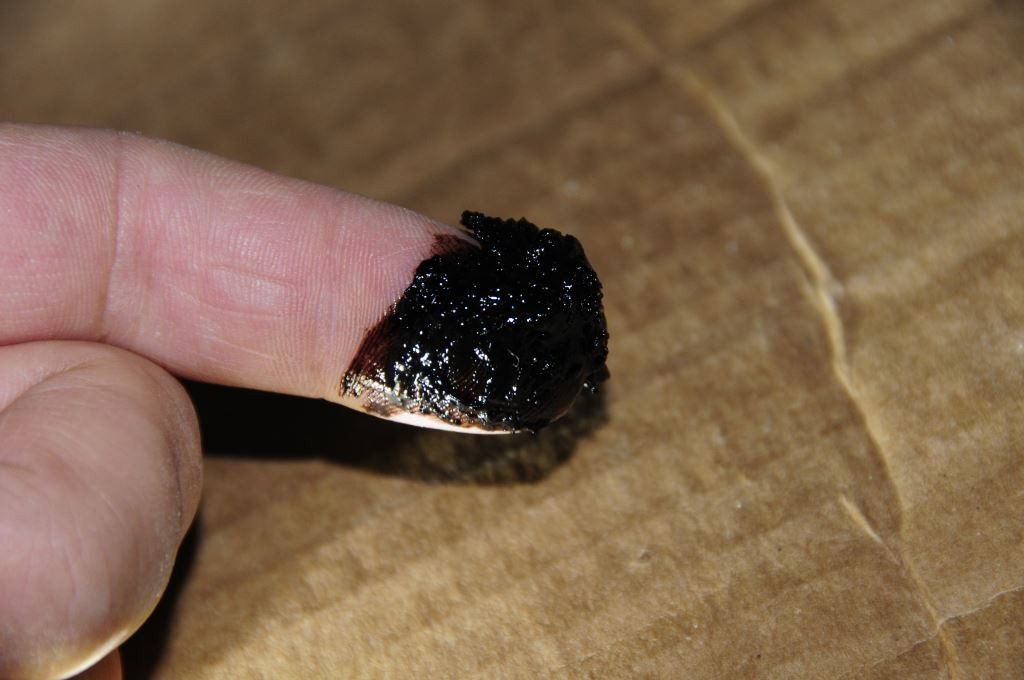
Asphaltene is a common and natural diesel contaminant, it is essentially mineral based particles, or dirt. It is abrasive and especially harmful to fuel injection systems should it make its way past fuel filters.
Properly designed fuel tanks make cleaning straightforward and relatively pain-free. Undoubtedly, among the most important features of a well-designed fuel tank is the inspection port, or ports depending on tank size. If no ports are present, and severe contamination is discovered, the prospects for a vessel owner can be daunting, including relying on a boat yard or contractor with whom you have no experience, to cut holes in your fuel tanks. My philosophy, born of experience in cleaning hundreds of tanks, calls for a preemptive approach, one in which inspection ports are installed before they are needed, at a time and place of your choosing, by those you know and trust.
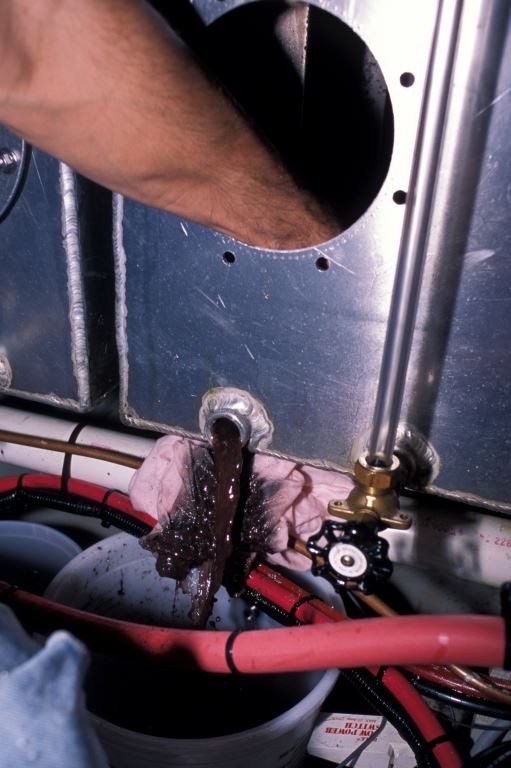
With inspection ports, tank cleaning becomes very straightforward. It can be accomplished by a vessel owner if necessary, even in remote locations.
DESIGN
Virtually all fuel tanks should possess an inspection/clean out port, in every baffled chamber. An eight-foot long tank, which is equipped with two baffles, making for three chambers, must therefore be equipped with three inspection ports, or one inspection port large enough for a person to enter, and then removable hatches or covers located within baffles, again large enough for a person to pass through. An inspection port into just one of these chambers, with no access beyond baffles, will only allow entry into one third of the tank’s interior, while dirt, debris and other contaminates will invariably distribute themselves throughout the tank. The worst or heaviest detritus, including water, will settle in the lowest part of the tank, which may be in a chamber that is not equipped with an inspection port.
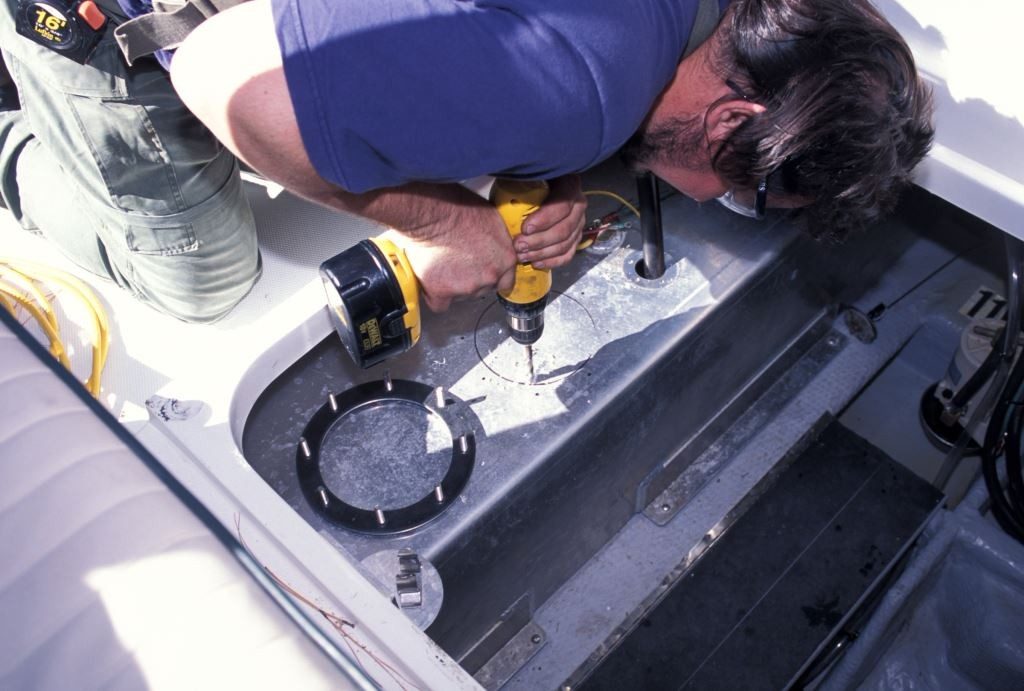
A technician installs an inspection port on an aluminum diesel tank. Debris created by cutting and drilling must be cleaned from the tank, however, this is typically easily accomplished using the now ample access.
The access ports themselves should be, in the case of metallic fuel tanks, constructed of the same material as the tank itself, i.e. aluminum or steel. For non-metallic tanks, plastic or fiberglass, aluminum ports may be used. The cover plates must be thick and rigid enough to avoid distortion and thereby ensure a proper seal. Aluminum fuel tanks which are ABYC compliant are fabricated from 5000 series aluminum alloy. During tank fabrication, fine thread 5/16” stainless fasteners inserted from inside the tank, as studs, through a doubler plate, should be used to secure inspection port covers. Hex head fasteners can be permanently attached to the tank using high strength, permanent thread locking compound. The lid is then secured with self-locking stainless steel nuts.
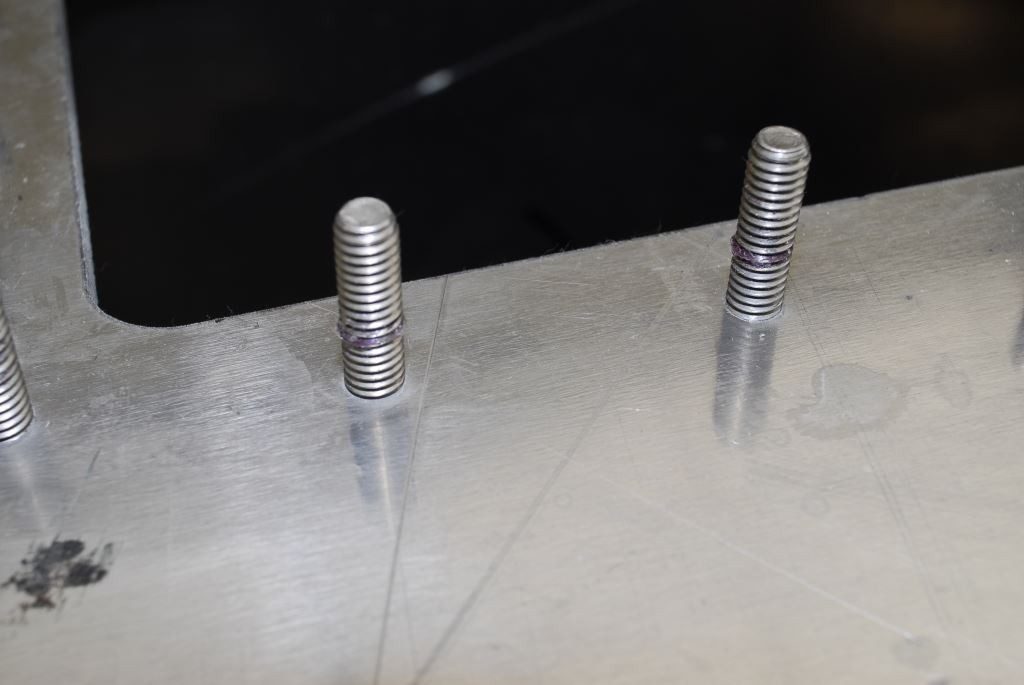
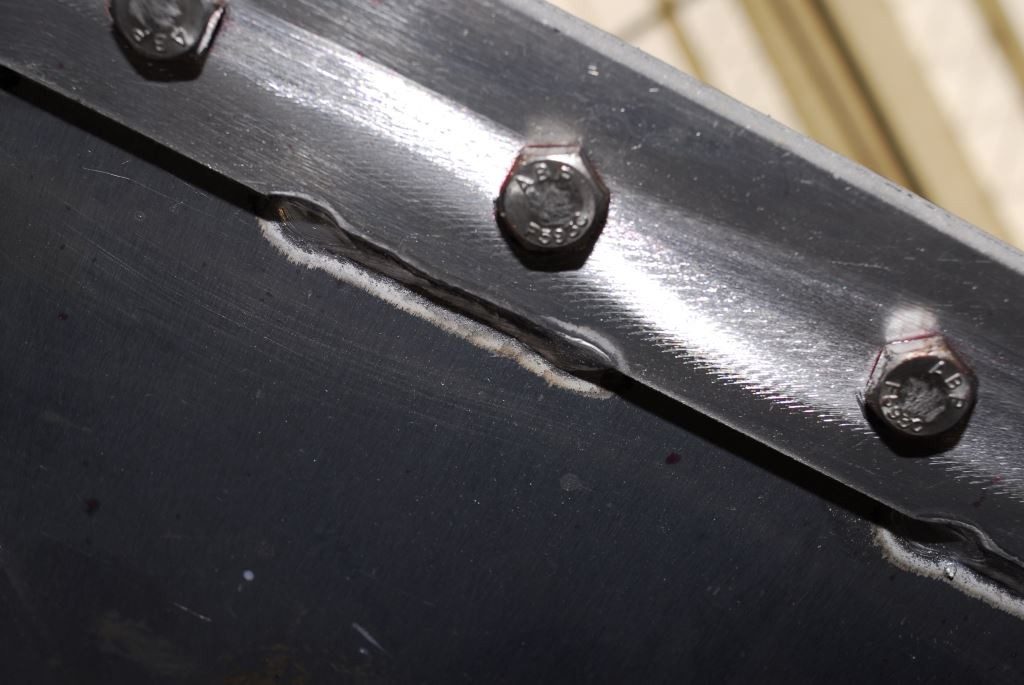
A doubler plate and cap screw installed inside a fuel tank provides a stud for securing an inspection port cover. The tank and doubler plate are tapped and the screw secured using a high strength thread locking compound.
The choice of gasket material is equally important. Fuel tank gaskets must have high standards; clearly, they must be able to withstand not only exposure to, but prolonged submersion in, diesel fuel. That’s right, submersion.
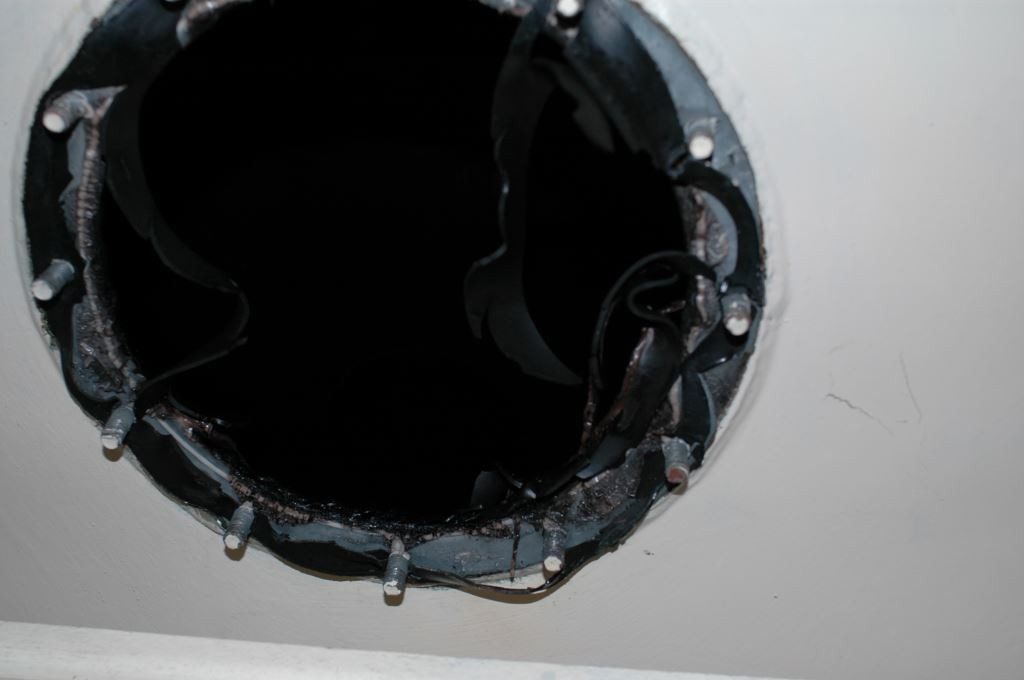
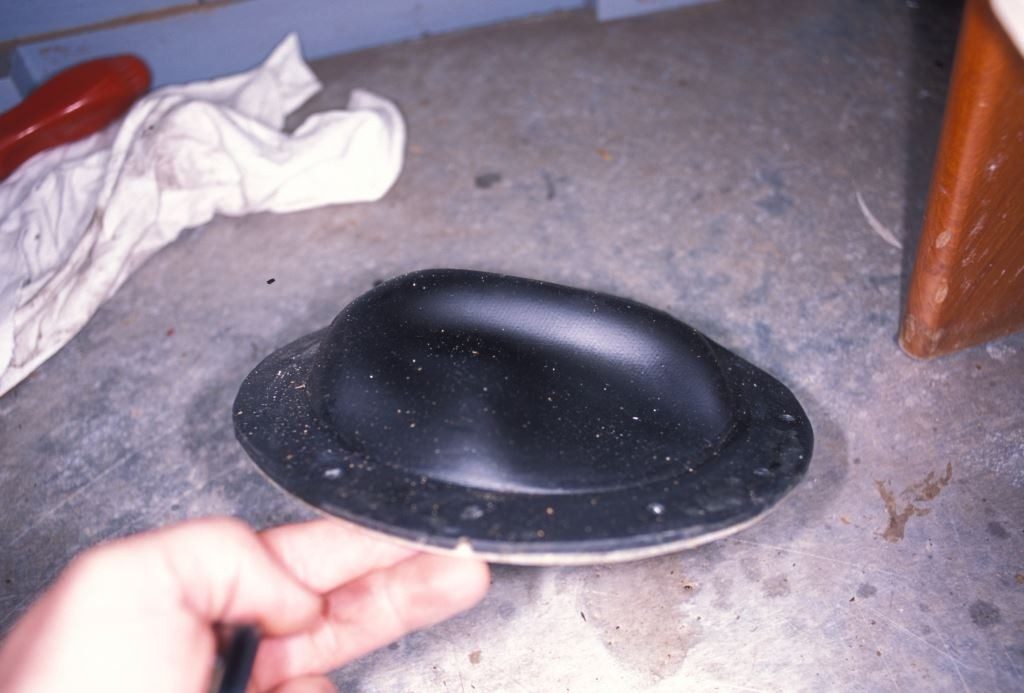
Not all rubber-like compounds are suitable for inspection port gaskets. The material shown here has failed, and could make its way to, and clog, the fuel pick up or plumbing.
While many tank inspection ports and gaskets are on the top of the tank, it’s not uncommon for ports to be installed on the sides of diesel tanks (this is prohibited for gasoline tanks), and many tanks are topped off, submerging even top-mounted ports and gaskets.

Not only should tanks be equipped with inspection ports, they must be accessible after the tank has been installed. For those mounted on tank tops, this often means removable sole hatches.
While neoprene is commonly used and is fuel resistant, Buna-N, also known as Nitrile, is a more desirable choice, it is essentially fuel-proof; in a 40-60 durometer on the Shore A scale (an eraser is roughly equivalent to 40, and tire tread 60), in a 1/4” thickness (thicker, and softer, if the surface is irregular); it makes for an ideal gasket. The given durometer is firm enough so that it will not distort when clamped between the cover and tank, yet soft enough to make up for slight irregularities between these two surfaces.
The most common error encountered when installing inspection ports, or resealing them, involves the use of gasket sealing compounds. Few if any gasket-sealing compounds will stand up to constant immersion in fuel. If a gasket, and the surfaces between which it is sandwiched, cannot be made to seal without the use of “filler”, then there is a larger problem at hand. Using the proper gasket material and ensuring the gasket surfaces are parallel and free of irregularities, will negate the need for gasket compound, thereby avoiding leaks caused by its deterioration. Installing gaskets without gasket sealant also makes them far easier to remove, and reduces the likelihood of damage to the gasket during the removal process. Gaskets should be installed with a light film of Teflon or silicone grease, doing so will prevent binding, and improve sealing characteristics, while making removal easier.
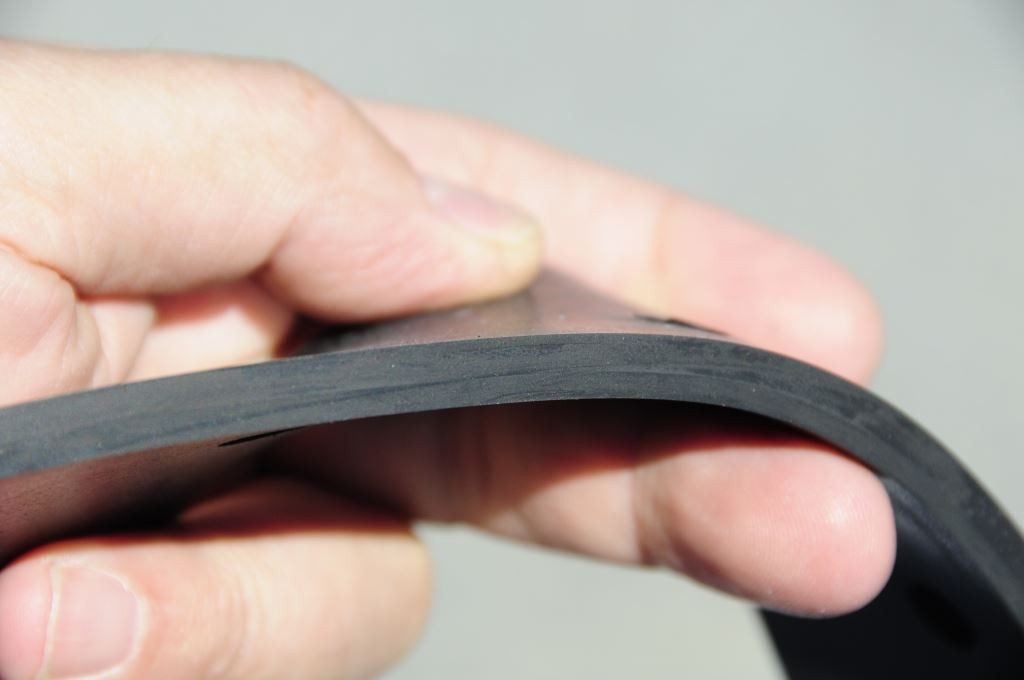
The ideal inspection port gasket material must be fuel-proof, and capable of absorbing minor tank surface irregularities without deforming excessively when compressed.
If your tanks have been fabricated without inspection ports, not all hope is lost. Ports can often be added to diesel tanks relatively easily and inexpensively. The challenge often involves insufficient tank wall thickness to facilitate drilling and tapping. Even ¼” thick aluminum tanks would be marginal for drilling and tapping for fasteners, and the aforementioned studs and doubler plate installation requires welding, on the inside of the tank, making it impractical after the tank has been built.
Fortunately, a system is available for after-market inspection port installation. Made by Sea-Built, of Seattle, Washington, it involves the installation of an ingenious yet simple ‘split ring’, which has studs permanently attached to it, inside the tank. The studs fit through template-drilled holes. This system works well regardless of tank wall thickness because it affords stiffness to the port opening, helping to ensure a flat gasket surface. It can be used on virtually any tank, of any material provided the surfaces are relatively flat.
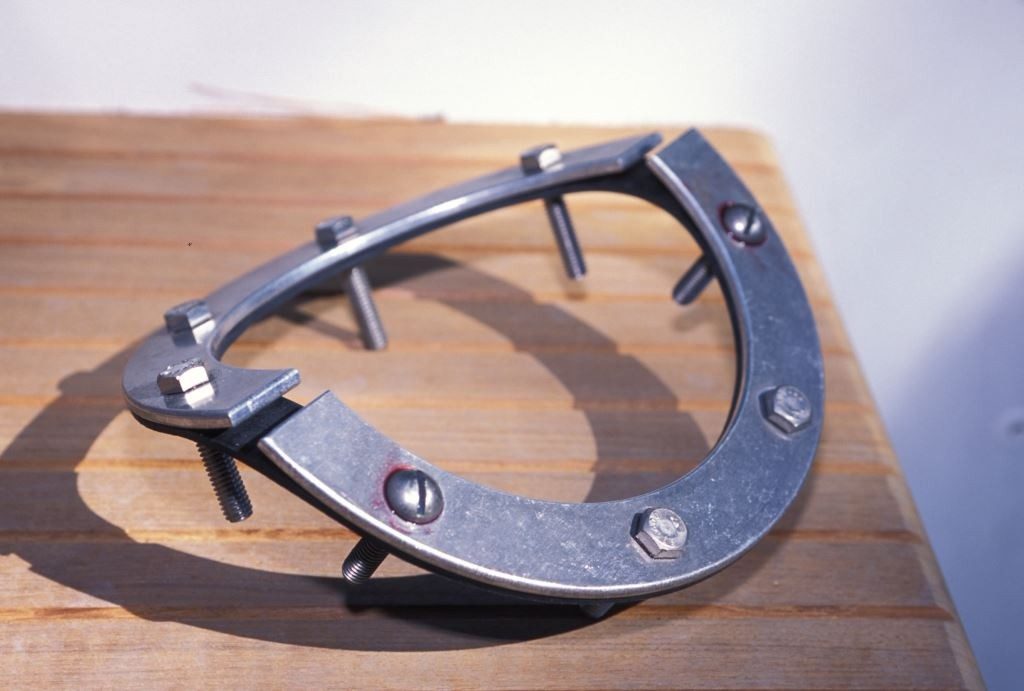
The ‘split ring’ backing plate that makes up part of the Sea-Built tank inspection port system.
In addition to inspection ports, stripper tubes are another weapon used in the battle against dirty tanks. This feature allows the worst dirt, sludge and water to be pumped off the lowest part of the tank. It consists of a tube, similar to the fuel pick-up, except it extends closer to the bottom of the tank (the fuel supply pick-up and return tubes should extend to within 5/8” of the tank bottom, while the stripper tube resides much closer, to within ¼”), or better still, into a dedicated sump. When a pump is attached to this tube, be it manual or electric, it’s a quick and easy method of maintaining or confirming a tank’s cleanliness. Depending on the quality and quantity of fuel used, you may “strip” the tank seasonally, monthly or as necessary. Discharging a small sample into a clear container is like performing a quick blood test. Stripper tubes should be equipped with valves and capped to prevent the possibility of siphoning the contents of the tank into the bilge. They can be added to most tanks.
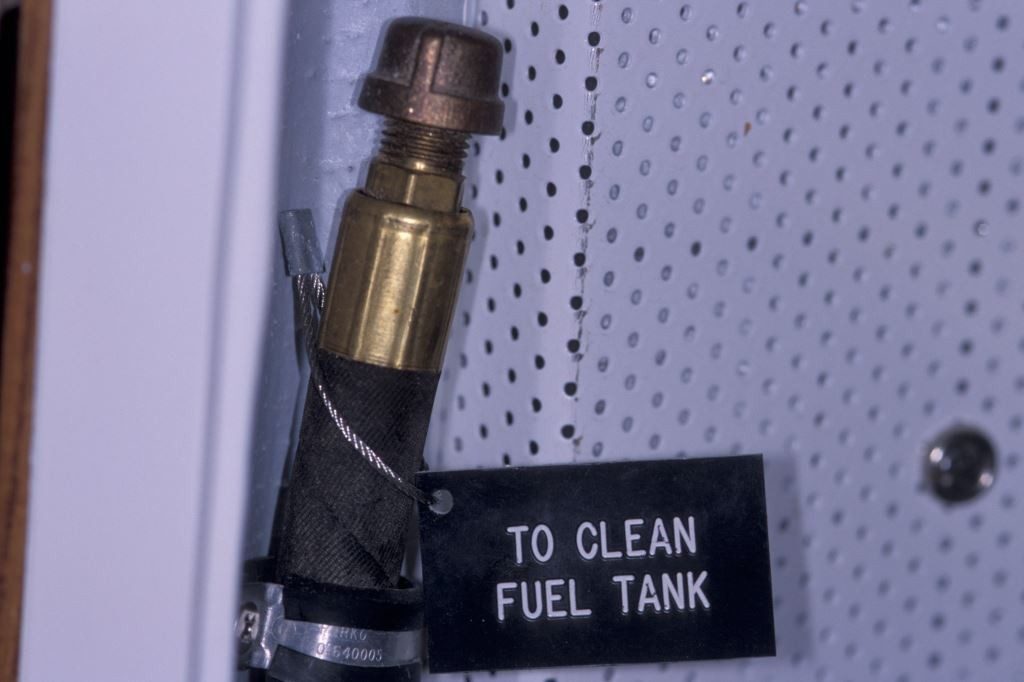
Stripper tubes can be used to remove water and other contaminants from tank bottoms before they can accumulate. They can be included when tanks are built, or added after the fact.
While drains are also effective for diesel tanks, the stripper tube is less leak-prone, and for a drain to be effective it must be located at the absolute lowest portion of the tank, and unless it’s in a well that’s difficult to achieve. Drains installed at the bottom of a diesel tank, while not prohibited by ABYC (they are prohibited for gasoline), present a far greater risk for leaks or accidental drainage. A boat stored at a yard where I once worked ended up with a bilge full of diesel when a worker inadvertently bumped into the ball valve located at the bottom of the tank. It was just a slow drip, but over the course of a month, a significant amount of fuel accumulated in the bilge. Stripper tubes are, if the above precautions are followed, less likely to lead to such leaks.
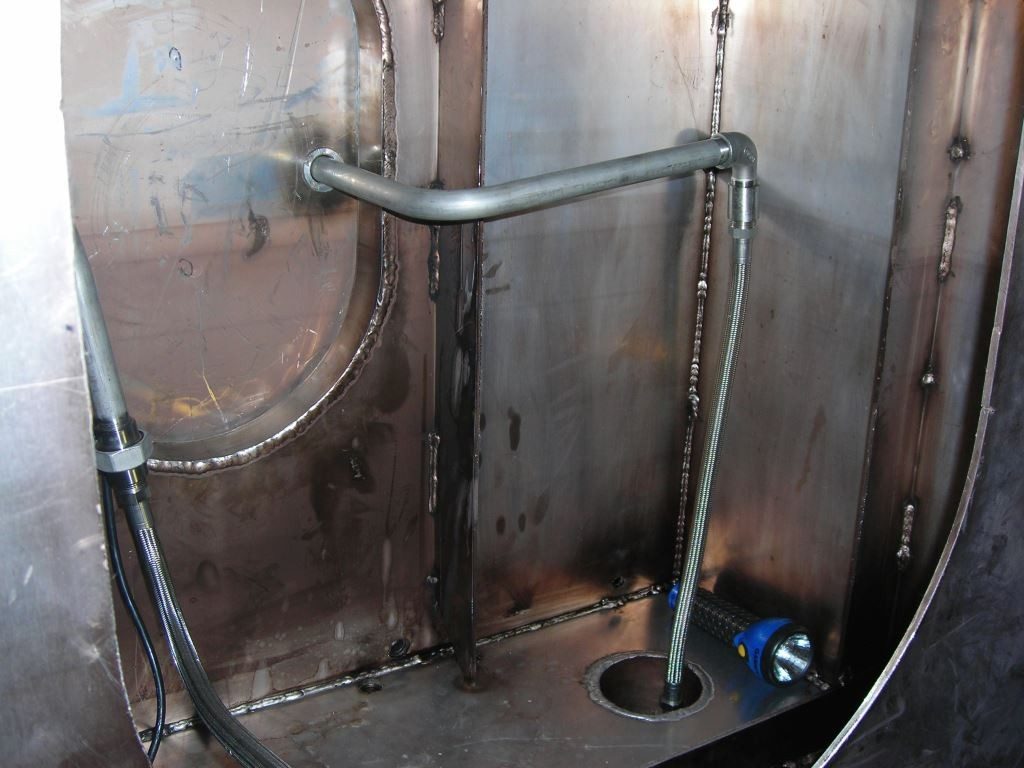
This tank (the image has been captured from within the tank) has been equipped with a stripper tube that uses a weighted, steel braided pick up hose that is suspended within the tank’s collection well.
CLEANING
The only reliable way to clean a fuel tank is to access its interior. No amount of flushing or pressurized wand spraying will clean a tank via the fill port, or a single access hatch in a baffled tank. As mentioned previously, this requires access ports into each chamber, and these ports must be accessible after the tank is installed. An access hatch on the top of a tank, with a scant few inches of clearance between tank top and overhead, is of little value.
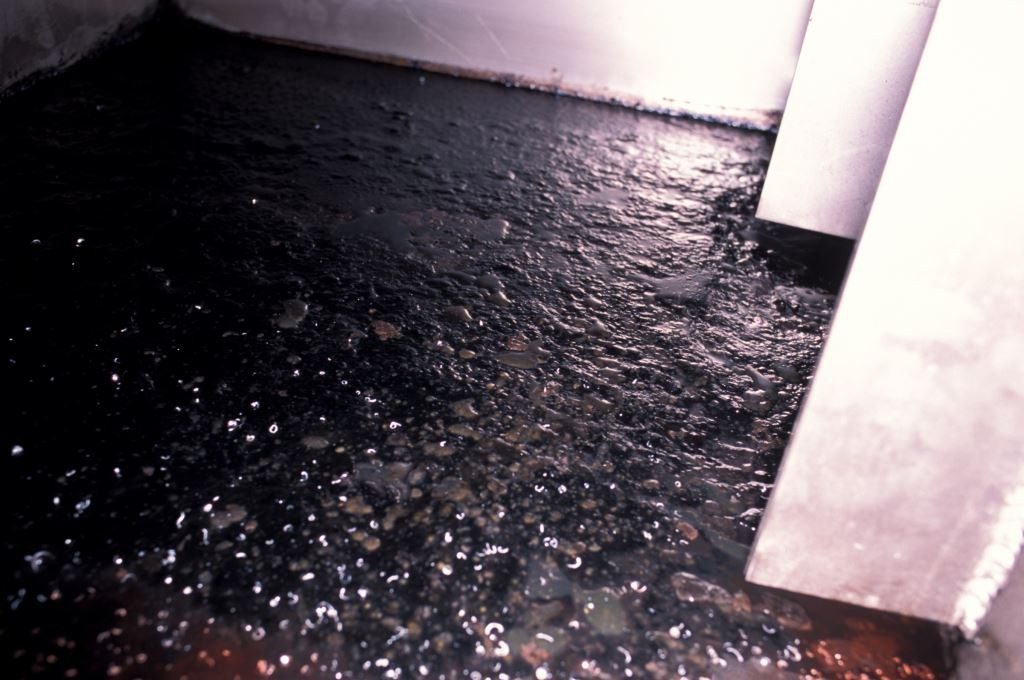
A heavily contaminated fuel tank bottom, viewed from an inspection port.
Begin by completely emptying the tank. For smaller quantities, if the fuel is heavily contaminated and thus not worth keeping, pump or siphon it into suitable containers and take it to the local reclamation center. Most recycling centers, and commercial waste oil collection outfits, consider no. 2 diesel to be the same as waste oil for the purposes of disposal and transport/pump-out. For larger tanks, dockside pump out services will come to the yard or dock where the work is being performed (Safety-Kleen is one such nation-wide outfit). Of course, this once again means the fuel is disposed of and its value forfeited. The alternative is to pump the fuel into suitable drums or a container, filtering it as it’s pumped out and back aboard. Many boat yards have a dedicated high volume portable diesel pump coupled with a large filter which will polish the fuel as it’s being moved.
Once the tanks have been emptied, the real work begins. Remove all of the inspection port covers as well as the pickup tube, and return tube if equipped (returns benefit from drop tubes, they reduce aeration of the fuel from splashing while underway, and reduce the likelihood of air working its way into the fuel system after shut down). If the pickup or return tubes are equipped with screens, remove them. These screens cause untold grief by catching contaminants where they are least easy to observe or clean out, in the tank rather than the filters.
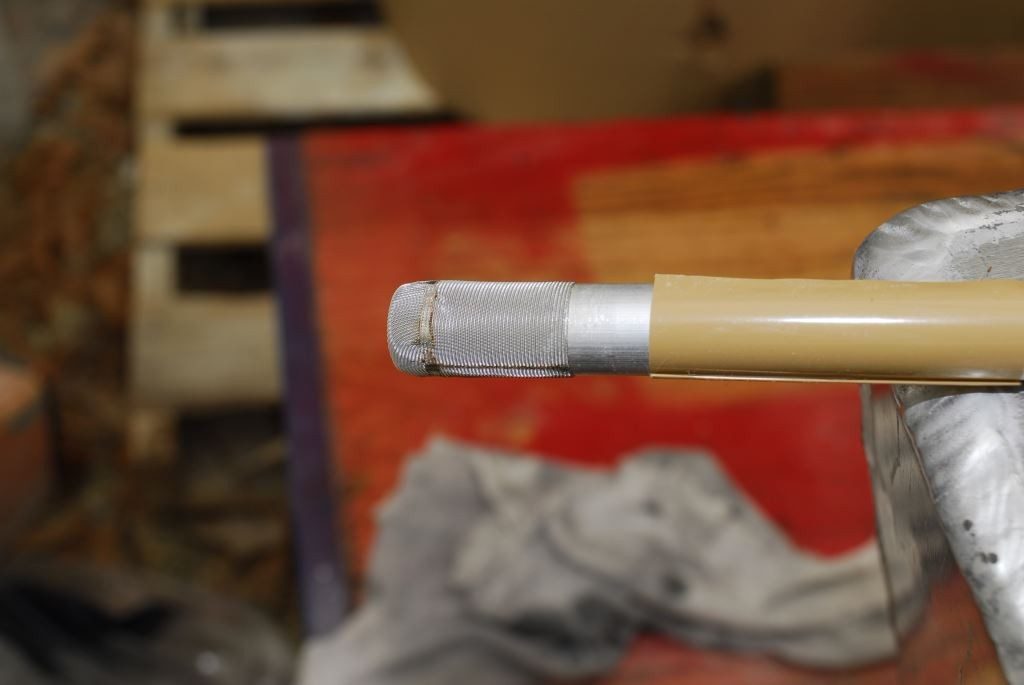
While the intention is good, screens installed on the ends of fuel pick up tubes more often than not lead to fuel restrictions. Cleaning the pick-up screen requires its removal, which is inconvenient at best. Ideally, contaminants should be allowed to travel to the primary fuel filter, where they can be easily removed.
A word of caution is in order regarding cover plate interchangeability. Many cover plates are custom made for each application. This means, they may fit only one access port properly, and in only one orientation. Before removing any plates, number them, and place a corresponding number on the tank surface, indexing them as to their orientation. Pickup tubes, if there is more than one, must also be numbered for the same reasons.
Once all cover plates, and pickups are removed (senders should also be removed to prevent damage and clean them as well), inspect the interior of the tank using a powerful light. The consistency of the contaminant will determine the tools to be used. Mud-like asphaltene responds well to a wide blade paint scraper (if the tank is metallic, in order to avoid galvanic corrosion issues if water should enter the tank, only non-metallic tools should be used), then clean diesel fuel or kerosene, and finally lint free rags (available from auto parts shops). Under no circumstances should oil absorbent pads be used inside any fuel tank, they are far too prone to shedding material that is very difficult to see when wet. Remember, the fuel used for cleaning must be properly disposed of, as you would dispose of waste oil. Biological based ooze may require hot water and a scrub brush (never use a steel brush).
While it may seem counterintuitive, the most environmentally and user-friendly method of cleaning the more stubborn accumulations of tank contamination, involves the use of a hot water pressure washer. Forty-five and ninety degree attachments are available for the wand, and these will facilitate access to the interior of most tanks. Hot water pressure washers, often incorrectly referred to as steam cleaners, can be rented at most equipment rental houses. The beauty of this machine is its ability to clean without the use of solvents. The hot high-pressure water will emulsify and dissolve most accumulated contaminants. In order to prevent it from being splashed within the tank, large “scoopable” crud and ooze must be removed manually before pressure washing can begin.
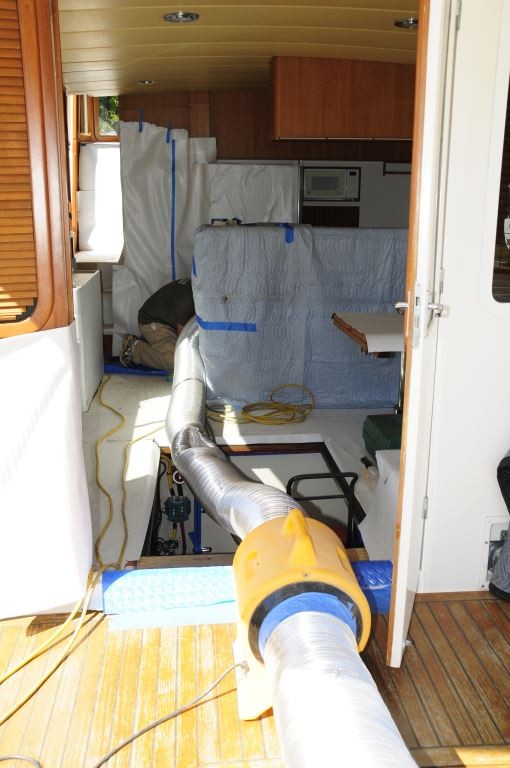
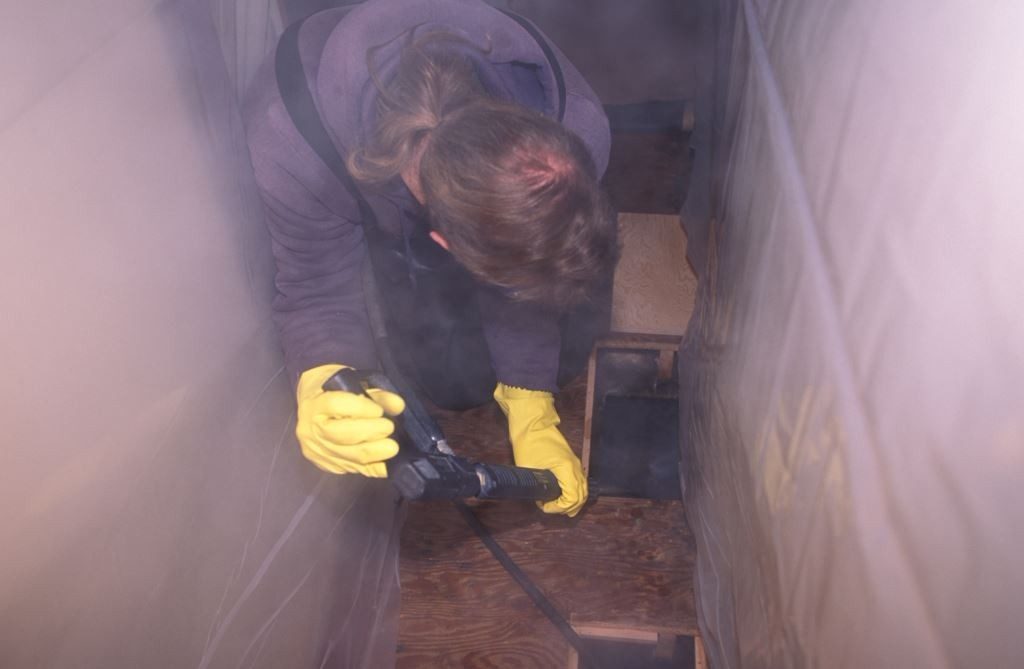
Hot water pressure washers are an effective tool for tank cleaning; they require no solvent and often even eliminate the need for wiping and scrubbing. However, accumulated debris should be removed from the tank bottom before washing commences. In most cases the tank area should be tented and negatively vented to prevent fumes from migrating into the vessel’s accommodation spaces.
When utilizing the hot water pressure washer, the wash water must be collected and properly disposed of, so it should be used sparingly. If allowed to stand in a closed container (not the tank!) for several days, emulsified fuel will usually rise to the surface, where it can be pumped off and/or absorbed with oil absorbent pads, and then properly disposed of.
If water is used for cleaning a fuel tank, it must be pumped out, and the tank must then be allowed to dry thoroughly before being placed back in service. A small fan placed over one of the inspection ports will help to expedite drying the interior of the tank. One note of caution in using the hot water pressure washer; even if solvents are not used, tenting and negative pressure ventilation will prevent vaporized fuel fumes from migrating into the vessel, while making for a safer environment for those doing the washing. Regardless, a respirator, gloves and eye protection must be worn. For confined spaces where ventilation options are limited, or in the event a tank must be entered, externally supplied air will be necessary for those carrying out the work.
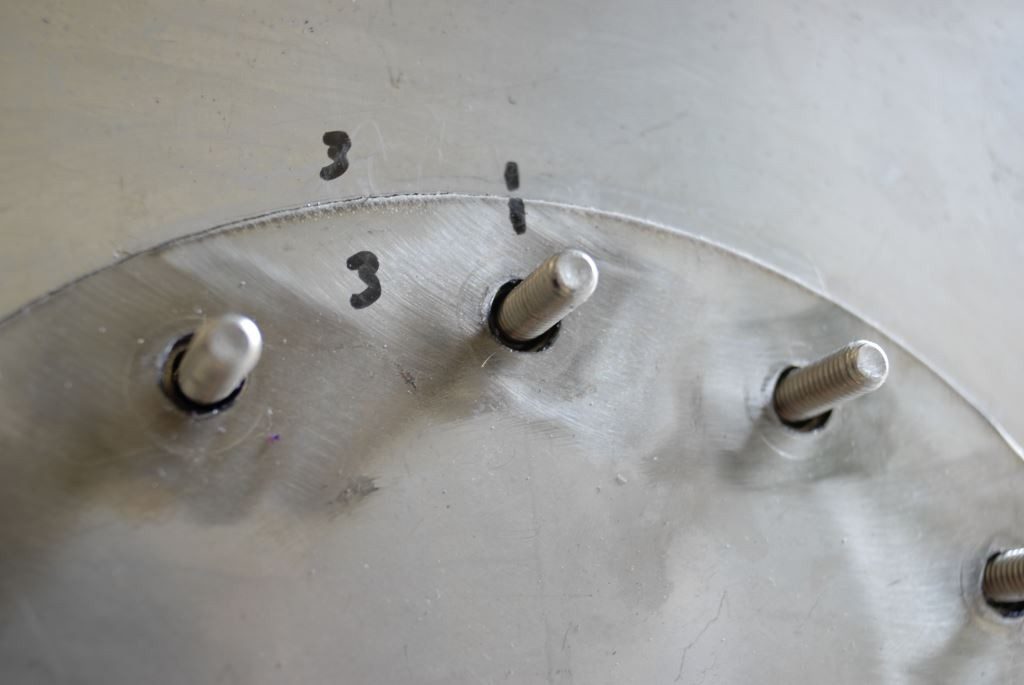
Some inspection ports covers must be reinstalled in the same orientation in which they were removed. Marking them, like the one shown here, facilitates this process.
Finally, carefully inspect the pick-up and return tubes for accumulated dirt and debris, then reinstall them using a fuel- proof thread sealant such as Highside Chemical’s Leak-Lock. Using an approved sealing compound on pipe threads, as opposed to gasket surfaces, is acceptable.
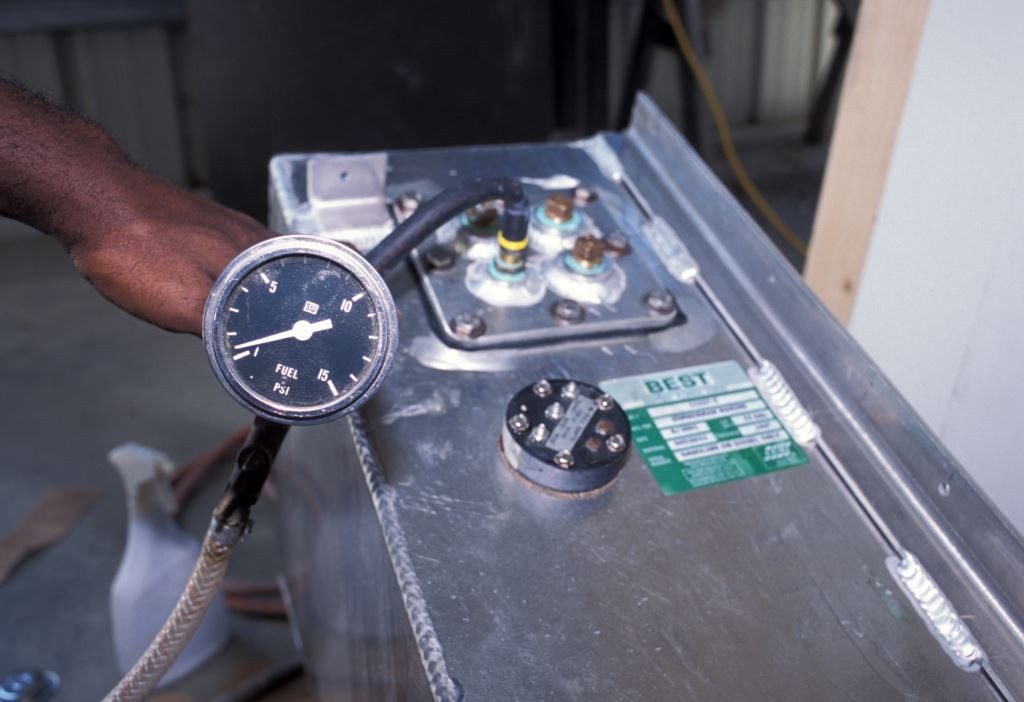
Pressure testing reassembled tanks can identify potential leak sources before fuel is added. Whenever a tank is breached pressure testing should be carried out.
Once fuel tanks are clean and reassembled, they should be pressure tested. This can be accomplished using some readily available tools including an automotive fuel pressure gauge and some assorted plumbing and hose fittings as well as a source of compressed air. Each tank should have a tag applied by the manufacturer indicating the rated test pressure, typically 5 psi or 3 psi. While somewhat time consuming, pressure testing is worth the effort, to determine that all fittings and cover plate gaskets have been installed in a manner that will prevent leaks before filling with fuel.
Whether you opt to undertake tank cleaning yourself, or entrust it to professionals, understanding how it should be done will pay dividends.

